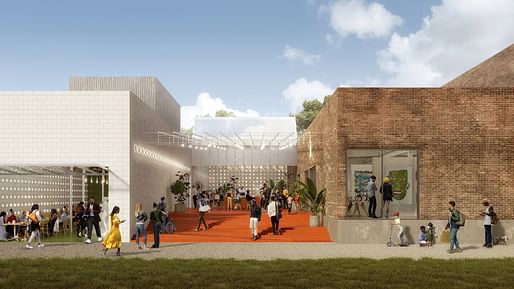
Detroit-based contemporary art exhibition space Library Street Collective has announced a partnership with OMA to transform a former 1900s-era commercial bakery and warehouse into a mixed-use arts education and public space.
Led by OMA Partner Jason Long, the adaptive reuse project will see the conversion of the 22,300-square-foot complex at 9301 Kercheval into a headquarters for two local arts nonprofits, Signal-Return and Progressive Arts Studio Collective (PASC). Nicknamed “LANTERN,” it will also feature roughly 5,300 square feet of affordable artist studios, an art gallery, and nearly 4,000 feet of creative retail. This will be centered around a 2,000-square-foot outdoor courtyard that will serve as an accessible community space and activity condenser.
PASC and Signal-Return will occupy approximately 8,500 square feet of combined space on the building’s main level. PASC is a program within disability services organization Services to Enhance Potential (STEP). It is the first art studio and exhibition program dedicated to supporting adults with developmental disabilities and mental health differences in Detroit and Wayne County. PASC’s new headquarters will provide studio space, workshops, and a gallery to showcase the work of artists in the program.
Signal-Return is a nonprofit organization dedicated to preserving and teaching traditional letterpress printing in Detroit. The new flagship location will expand their programming, which includes hands-on workshops, exhibitions, educational partnerships, and the sale of prints, ephemera, and gifts, with a primary focus on Detroit-based artists.
OMA aims to take advantage of the existing building’s current state of disrepair. An area missing both its roof and an end wall will be transformed into a courtyard at the heart of the building. It is defined as the primary entry with multiple frontages for all tenants. The courtyard will serve as an accessible public gateway and a hub for activity. Signal-Return and PASC’s programs are organized across existing structures to maximize points of access and potential for community interface.

As per the architects, “Production zones and artist studios create an active and inviting face to Amity Street; galleries line the courtyard to reinforce a public heart for the building; and neighborhood serving functions are orchestrated on the opposite side of the courtyard to consolidate the most public amenities along Kercheval Avenue.”
The existing sealed openings across the structure will be opened strategically. Operable windows will be inserted at the studios to allow for ventilation. In addition, gallery windows will be extruded to become art vitrines, and larger openings will offer potential indoor-outdoor production spaces. The south building, which is currently a solid expanse of concrete masonry, will open itself to its surroundings through 1,500 holes that will be drilled into its walls and filled with cylindrical glass blocks. This will subtly reveal activities within and make the space appear as a glowing lantern at night.
“PASC and Signal-Return are both extraordinary organizations with a multi-faceted approach to community building through the arts,” said Long. “To support and enhance their ambitions, we are both turning the building in on itself and out toward the neighborhood to bring a new density of activity and creative life to East Village.”
“The core of our mission in East Village is focused on creating an inclusive community centered around the arts,” Library Street Collective co-founder Anthony Curis added. “Progressive Art Studio Collective (PASC) and Signal-Return are two highly impactful nonprofits providing vital support and inspiration to the local arts community. We’re thrilled to welcome them to the neighborhood.”
5 Comments
why are archviz people scared of shadows?
this is such a basic, unambitious and generic project for an obscure organization. i feel bad criticizing a project for what appears to be a well meaning local group, but this design shows no real thought at all, just a half-hearted and very clumsy copy of a few old OMA gimmicks. It doesn't make any sense that an international prestige firm would have any involvement or even interest. What's going on here?
That's OMA NY in a nutshell. They are pretty much run independently from Rotterdam and under the creative control of their own principals. Look at their recent American projects. None of them have the intellectual rigor or formal/material/spatial bravado of the OMA that so influenced the field. Instead they rely on tired tropes and gimmicks for an increasingly corporate-dominated clientele.
A famous brand name and being able to get your stuff shown by the design news media is 97% of the game. Now more than ever.
Who knows what voodoo goes into the selection of a firm like OMA doing something like this (personal relationship, donor involvement, personal history). We sometimes savage firms like OMA/BIG for only doing large scaled developments for the rich and so the idea that they turn their attention to more obscure cities and smaller scale work doesn't seem awful on the face of it (if we give them the benefit of the doubt).
Perhaps OMAs exposure will help this organization at best. At worst, the lack of grounding in a realistic budget and constructability could cause it to suffer under BIGs design for a small arts organization in Park City that failed to muster support from the community who rejected the aggressiveness of a design that was actually pretty solid (literally and figuratively - ha).
It should be noted that Library Street Collective is also doing great work with P.R.O. Arch on a church re-use as an arts center and housing in the area.
Block this user
Are you sure you want to block this user and hide all related comments throughout the site?
Archinect
This is your first comment on Archinect. Your comment will be visible once approved.